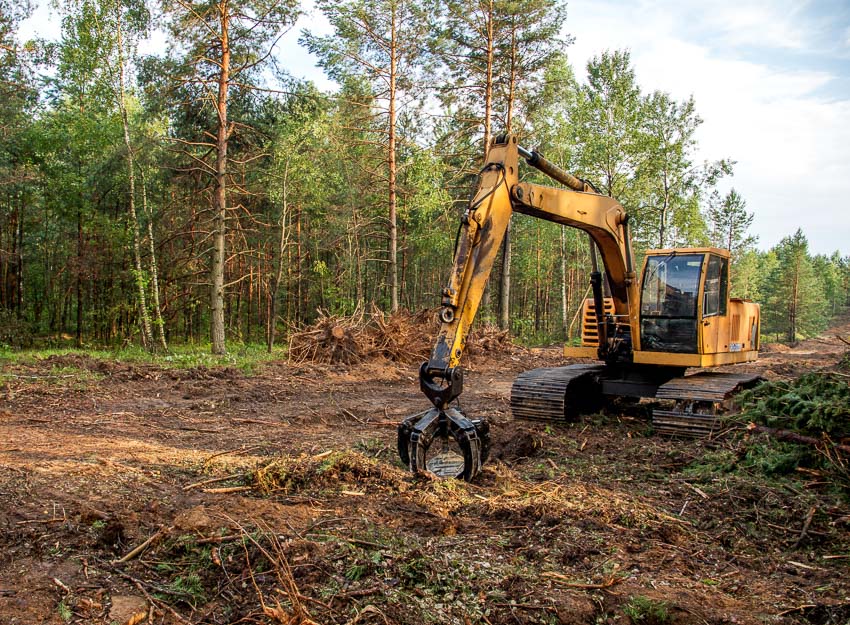Land clearing is often necessary before your outdoor project can begin. Depending on various factors, clearing land costs up to $6,000 per acre. Explore the costs and discover how it affects property values with this comprehensive land clearing cost guide.
Breaking Down Land Clearing Cost
Land clearing is the removal of trees, shrubs, undergrowth, stumps, and roots to prepare land for various uses, like expanding your yard or making room for a garden or swimming pool.
Professionals usually do land clearing with the proper equipment and experience because it is hard work that poses inherent risks.
What Comprises the Cost of Land Clearing
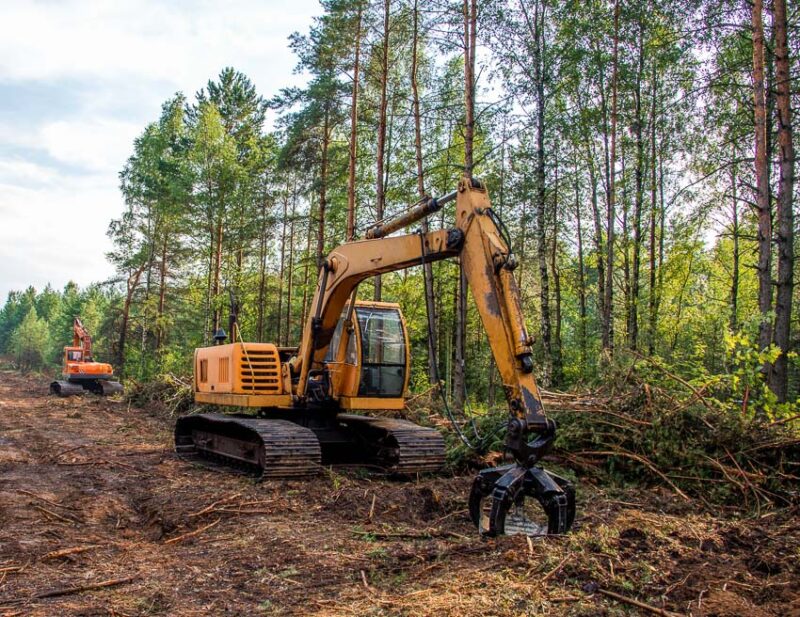
Landscaping professionals with the proper equipment to clear land charge about $300 to $1,200 per hour, depending on where you live and the type of equipment they have. It costs more to clear heavily forested land, but prices also depend on several other factors.
Simply stated, the cost of land clearing is based on the following:
- The size of the area to be cleared,
- The type of debris,
- How much debris there is, and
- How it is cleared.
Average Cost Ranges
The average land clearing cost per acre varies, usually between $250 and $1,000. Heavily forested land costs more, up to $6,000 per acre.
The base price typically includes the removal of trees and brush. When getting a price estimate, check to see that your service professional has included tree stump and root removal in his quote.
Most people pay about $2,500 to $4,500 to have land cleared. Remember that it’s not always necessary to clear your entire property. You may only need to clear enough land for a house site, utilities, and a driveway.
The average cost of clearing land for a house site is $2,500.
The cost to clear land is usually calculated on an acre or half-acre base price because landscaping professionals must cover the costs of moving their heavy equipment onto a job site. If you’re only clearing a small brushy area, hiring a landscaping worker who charges $50 to $120 per hour to do the work by hand can cost less.
Determining Costs
Land clearing cost varies depending on several factors. Easily accessed lots with few trees will cost much less than land that is densely wooded and on a steep hillside. Learn more about the factors that influence the cost to clear land so you can estimate the cost of your project.
Factors That Influence Clearing Cost
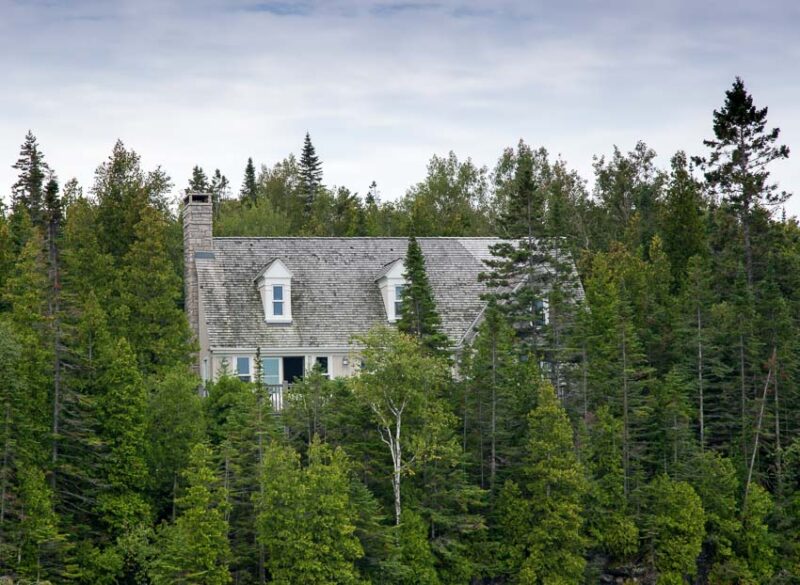
Here are the most influential factors that affect land clearing costs.
Scope
The more extensive your project, the more it costs. For example, preparing land for a home site costs more than clearing the land of brush and trees.
Size and Density
The more land you have to clear, the more it will cost. Land with more trees and brush takes longer to clear so it will cost more.
Location
Land clearing costs vary by region. Areas with higher living costs or greater demand for land clearing services cost more. Rural areas typically have more contractors available, which can lower the costs.
Terrain
The type of terrain you have will affect the cost of clearing your land. It takes longer to clear trees and brush on steep, rocky terrain, and it’s more dangerous, so you need someone with the right experience and equipment.
Labor
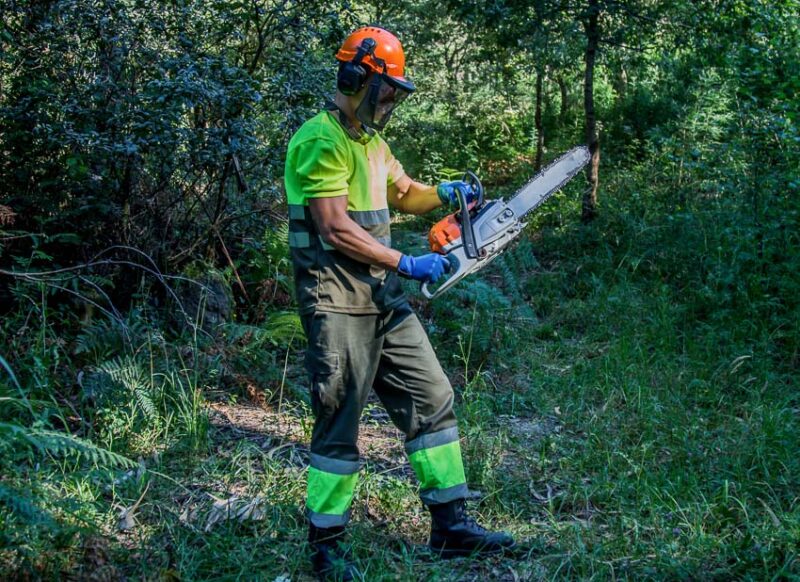
Regional labor markets play a significant role in any project, and there is a big price difference between skilled and unskilled labor. Landscaping professionals usually charge $50 to $120 per hour, but land clearing costs more, typically between $120 and $250.
Equipment
When you’re paying someone with heavy equipment, you’re paying for their hourly wage, and you’re also paying for the cost of their equipment. Their hourly price varies depending on the type of equipment they have.
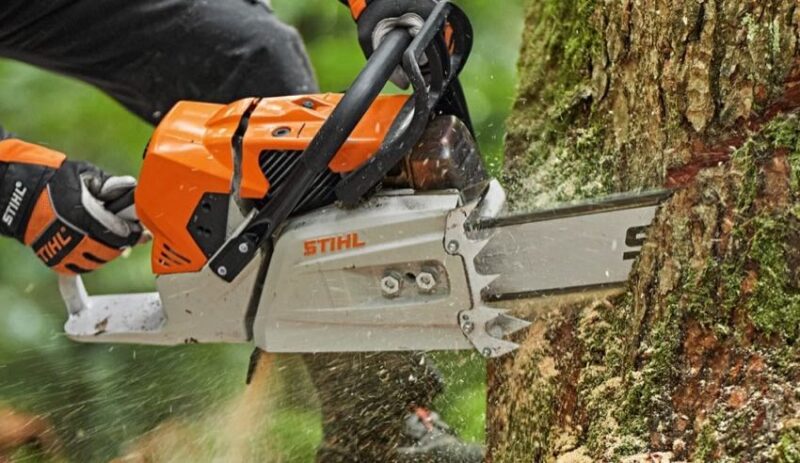
Some professionals use a chainsaw and a small skid steer, while others have large forestry mulchers that can clear up to four acres per day. Expect to pay $300 to $1,200 per hour, depending on the type of equipment.
Equipment with higher costs is usually more efficient.
Forestry Mulching
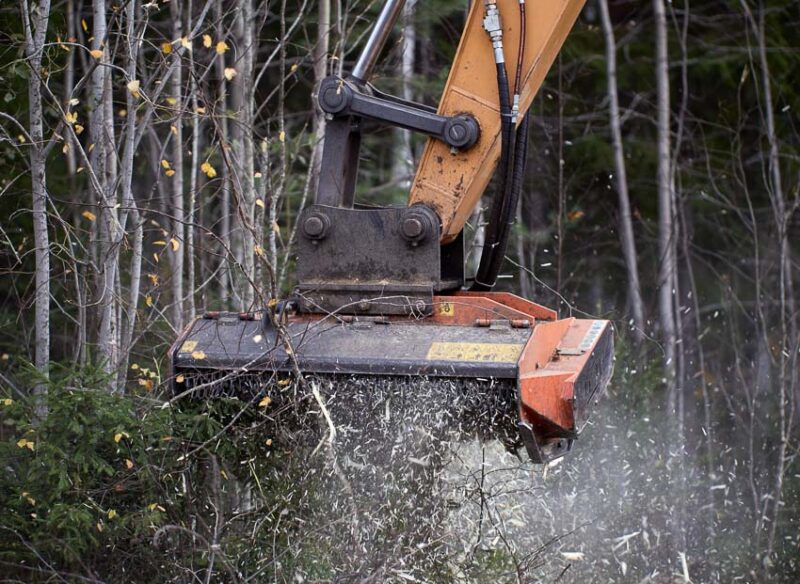
There are different types and sizes of forestry mulchers, which are large pieces of equipment that shred trees, branches, roots, and stumps and turn them into mulch. Mulching costs more per hour, but overall, it could cost you less because you’ll save on debris removal.
Tree Removal
Clearing a small area to extend your backyard or build a new fence is much different than clearing a few acres. For small areas, it can be less expensive to hire a tree removal service to remove a few trees and then hire someone else to come in and clear the area.
Grading and Leveling
You will pay more if your land clearing involves grading, leveling, or other excavation services. Grading and leveling a building site costs about $1 to $4 per square foot, and the cost to remove dirt could be extra.
Permits
Depending on local and state regulations, you may need a permit to clear your land. The cost of a permit to clear land varies, ranging from $150 to $500 on average. Some counties and states charge a flat fee per acre.
Surveys
Boundary line mistakes can be costly, so you should have your land surveyed. Most land surveys cost about $500, but they can be more in some areas or for larger properties.
Debris Removal
Check to see if debris removal is included in the base price. Otherwise, you could spend considerably more to have it hauled away.
The cost of debris removal varies greatly depending on the type of debris and where you live.
Erosion Control
Even on flat ground, you may need to take measures to control erosion when clearing land. Erosion can damage nearby water sources, impact wildlife , and cause topsoil depletion, so it’s critical to address it, especially if you are working on a steep hillside.
Estimating the Cost of Your Land Clearing Project
You can estimate the cost of your land clearing project to get a basic idea of how much it will cost you, but all of these factors must be considered, and the actual cost can vary.
For budgeting purposes, estimate the cost of your land-clearing project by determining how much area you need to clear.
Walk off the area that you need to clear to find the measurements, then multiply the length and width in feet to find the area. Divide that number by 43,560, which is the number of square feet in an acre.
Use the following prices to estimate your cost, keeping in mind the factors previously discussed:
- Cost to clear brush per acre–$300 to $600
- Cost to clear lightly forested land per acre–$600 to $1,000
- Cost to clear heavily forested land per acre–$1,000 to $6,000.
The only way to know for certain how much it will cost is to get a few quotes. Landscape professionals have the experience and knowledge about the tree density of your land and the geology in your area to give you an accurate quote.
The Impact of Land Clearing on Property Value
Learn more about the environmental, economic, and aesthetic benefits of land clearing and how your property values might change when you clear your land.
Does Clearing Your Property Increase Its Value?
Clearing land increases your property value for several reasons. It makes your property more usable for building and farming and increases the resale value. Land clearing also reduces fire and safety risks and enhances curb appeal.
If your land isn’t cleared properly, however, you run the risk of decreasing the value of your property. Potential problems include environmental impacts such as erosion, zoning, and land use issues.
The Pros and Cons of Land Clearing
Land clearing has significant global implications, as it reduces oxygen output, increases carbon dioxide, and causes soil erosion. However, it can also create new economic opportunities, and when it’s done right, land clearing can reduce competition between plants and improve soil quality.
Why Clear Out Your Land
Is clearing your land worth it? It can cost several thousand dollars, but land clearing has important benefits.
Learn why clearing land is important and compare the costs to benefits to help you make decisions about clearing your land.
The Benefits of Clearing Your Property
Clearing your land increases your property values, but that may not be important if you aren’t planning on selling. Consider the following benefits when using a cost-to-benefit analysis of land clearing.
Improved Aesthetics
Land clearing improves the look of your home and property. Well-maintained and manicured lawns, open fields, and wooded areas greatly enhance the visual appeal of a property.
Pest Reduction
Heavily forested land provides habitat for many animals, including pests like skunks, raccoons, gophers, rodents, and insects like ticks, which carry diseases. Clear some of the areas around your home to reduce their habitat.
Increased Accessibility
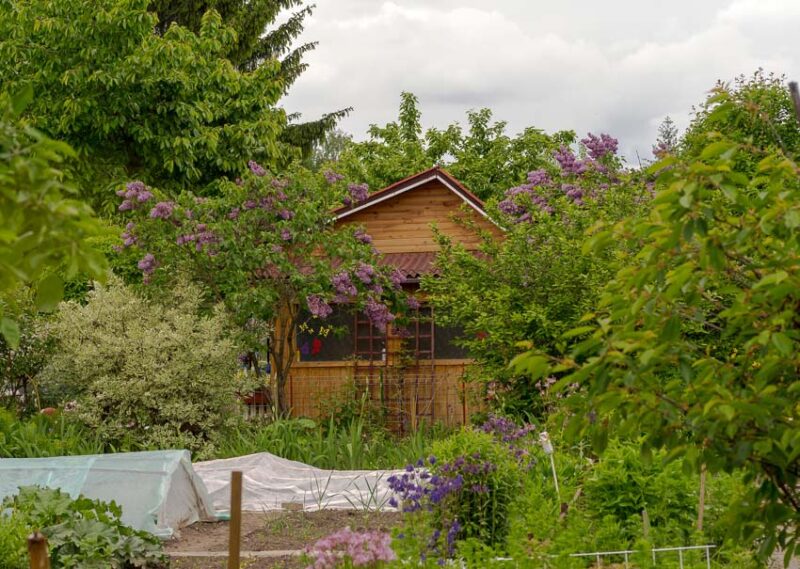
Parts of your property may be inaccessible because of trees and brush. Clearing away undergrowth and removing trees makes accessing certain parts of your land easier, making it more convenient to use and maintain.
Reduced Fire Risk
Increasing the defensible space around your home improves the chances that it can be saved if there is a forest fire in your area. For this reason, some areas have programs that can help you pay for land clearing costs.
Safety
Land clearing increases visibility, making it easier to observe when people are approaching your property. You may feel more secure if you can see the area around your home.
Invasive Species Removal
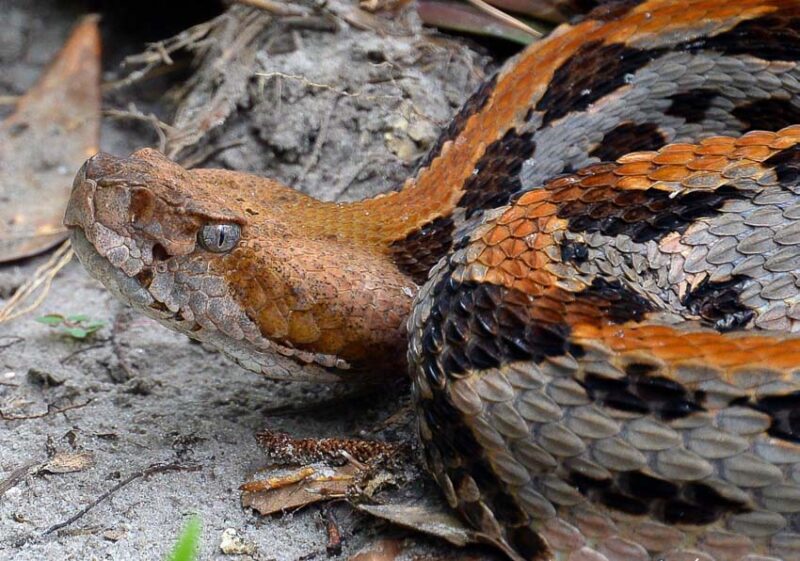
Clearing your land is good if you have problems with invasive species or poisonous plants. Natural resource management is an important part of stewarding your land.
Balancing Cost and Benefit
Clearing your land is a great way to build equity in your property, especially if you want to make your land more usable by adding fences, gardens, orchards, and outbuildings.
If you plan on doing the work yourself, remember that it’s hard work and time-consuming. Since it doesn’t have to be done all at once, you can take your time and save money with DIY land clearing.
Frequently Asked Questions About Land Clearing Cost
What is the average cost per acre for land clearing?
The average cost per acre for land clearing is between $700 and $6,000. Many factors influence the cost of land clearing, including the size of your property, the density of the trees and brush, and the geographic area.
Can land clearing increase the value of my property?
Land clearing increases the value of your property by making it more usable. Land clearing can also make your property more aesthetically pleasing and reduce fire danger risks.
If you plan on selling your property, it will be more attractive to buyers because they can avoid the time and cost of clearing the land themselves.
How can I reduce the cost of land clearing?
You can do some of the work yourself to reduce the cost of land clearing but be prepared because it’s hard work. Use pruning shears and a brush cutter to clear everything but the trees. Tree removal is best left to professionals.
Is land clearing always necessary before construction?
Unless you purchased a flat piece of land with no trees or brush, you will need to clear it before construction begins. Even a flat piece of land will require excavation because you must remove the topsoil and anything growing there.
How is the cost of land clearing calculated?
The cost of land clearing is usually calculated by the acre, and it costs about $700 to $6,000 to clear an acre of land, depending on several factors. Clearing and excavating a home site is usually based on square feet, usually costing between $1 to $4 per square foot.

